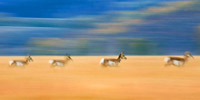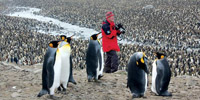Red Crab
Animals — Red Crab
INTERACTIVE RED CRAB PROFILE
RED CRAB (Gecarcoidea natalis)
The red crab is one of 14 species of land crabs found on Christmas Island. It is related to the purple land crab, Gecarcoidea lalandii, which is found in the Indian Ocean and western Pacific region. Its diet consists primarily of fresh and fallen leaves, fruits, flowers and seedlings, but a red crab will also eat dead members of its own species, bird carcasses, the invasive giant African snail and even edible human garbage.
Most of the year, red crabs, whose lungs are dependent upon moisture, stay in the dampness of the forests. But after the monsoons, humidity on Christmas Island rises to close to 90 percent, enabling them to leave their sanctuary and venture to the shoreline to breed. Females each produce as many as 100,000 eggs and then make a mad, desperate dash to the water to release them. Usually, only a few of the potential offspring will survive and eventually wash ashore as young crabs to struggle back to the forest.
Today, red crabs’ journey to and from the water is more perilous than ever before, thanks to the yellow crazy ant (Anoplolepis gracilipes), an invasive species introduced to the island in the early 20th century. The rapidly multiplying predator, which attacks red crabs and render them helpless by spraying acid in crabs' eyes and mouths, has killed off as much as a third of the red crab population in the last several decades.
Red crabs play a vital role in rejuvenating the forest. Their burrowing turns over the soil, which they fertilize with their droppings. They also eat seedlings of weeds, preventing them from overrunning the forest floor and pushing out other plant species.
MORE MIGRATIONS
-
Preserve their HabitatHelp conserve the natural landscapes of these migratory species.
-
Teacher ResourcesJoin the virtual assembly and access lesson plans specific to your area.
-
Nat Geo ExpeditionsTake a migration of your own with National Geographic Explorers.
-
Science Behind MigrationsHow do animals decide where to go, how long to stay, and when to leave?















